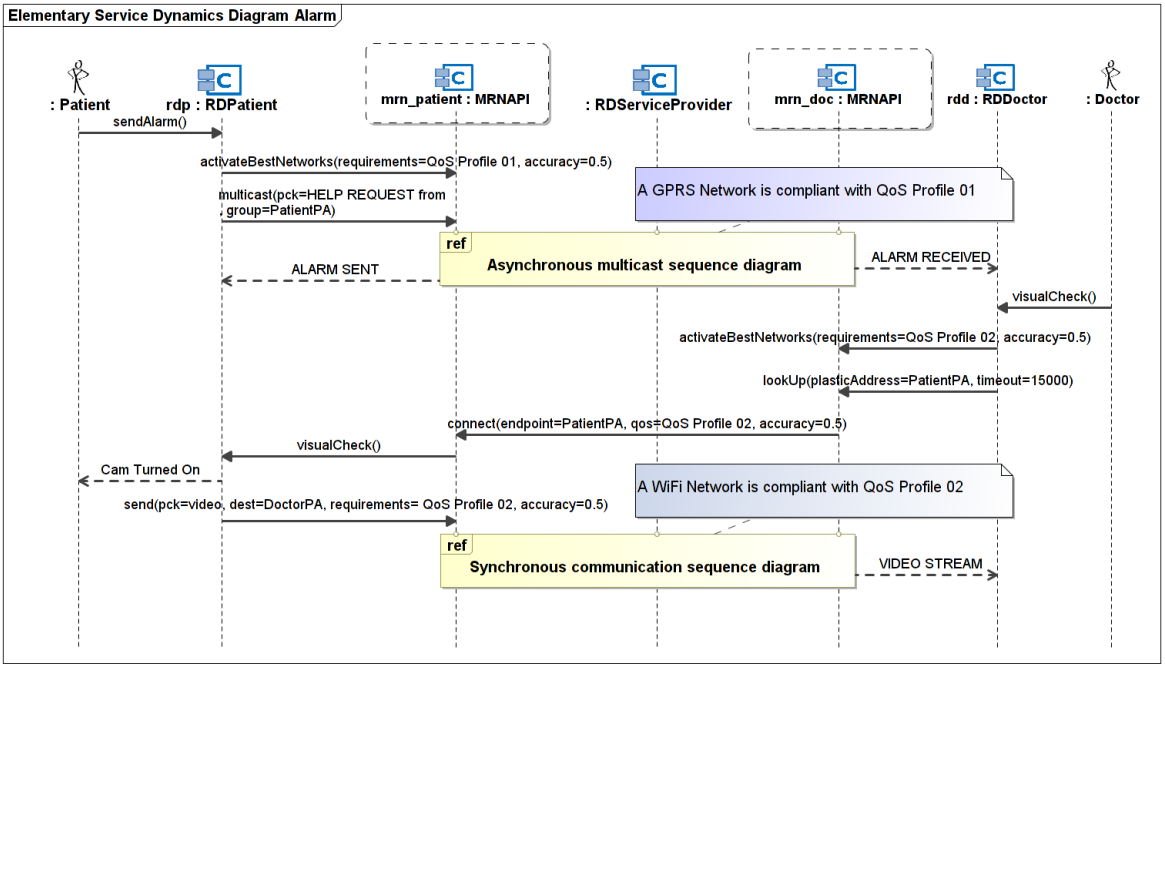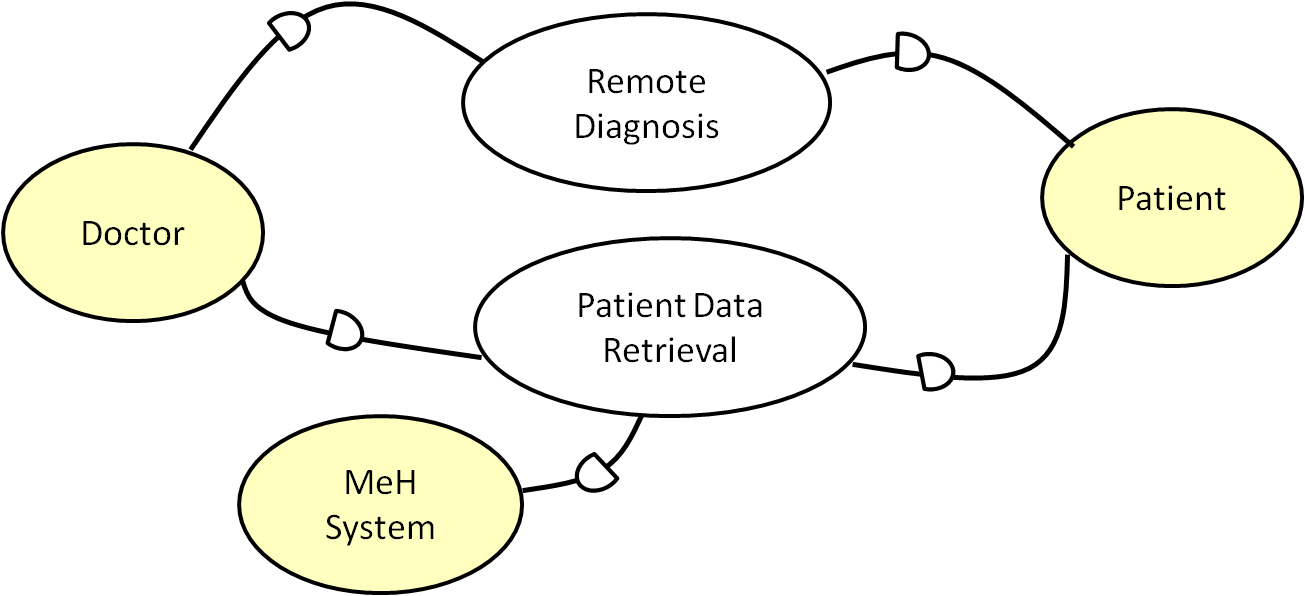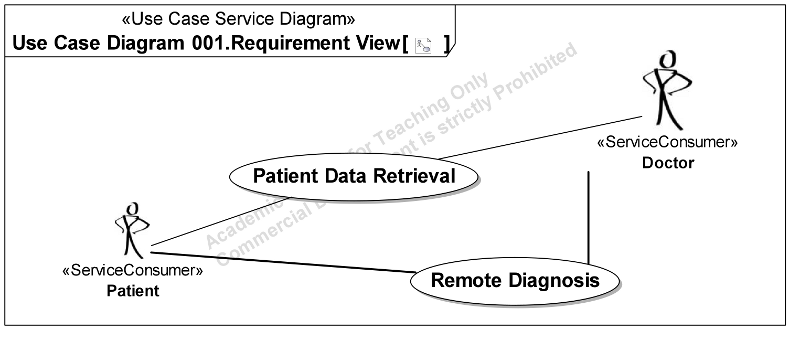Mobile eHealth MeH (PESOS 2012)
Contents
Business Goals and Domain Assumptions
In this page we briefly describe a case study, i.e. the Mobile eHealth (MeH), developed in the context of the IST PLASTIC project aimed at supporting self-adapting and context-aware services. The goal of the case study is to show how to model a service-based application and to demonstrate that model-based solutions are suitable to generate Quality of Service (QoS) models and adaptable code from service models.
In the following sections will be reported the Business Goals and the
Domain Assumptions for the current case study.
Business Goals
| Field | Description |
|---|---|
| UniqueID | EH-BG-01 |
| Short Name | Patient Data Retrìeval (PDR) |
| Type | Business Goals. |
| Description | By invoking the PDR service, the doctors retrieve mixed media information of their patients that combines text with or without different kinds of images referring to their personal data, their medical histories and patient-related diseases. The results can be displayed on the doctors’ handheld device. A more detailed description of this service is provided in [1]. |
| Rationale | Provide the service that is tailored to a certain execution context. |
| Involved Stakeholders | Doctors, Patients, MeH System |
| Conflicts | None |
| Supporting Materials | [2] |
| Priority of accomplishment | Must have. |
| Field | Description |
|---|---|
| UniqueID | EH-BG-02 |
| Short Name | Remote Diagnosis |
| Type | Business Goals. |
| Description | By invoking the RD service, the patients update some vital parameters (e.g. heart rate) thus to provide the knowledge aimed at monitoring their health. On the basis of such data an alarm is sent in case of warning conditions that can be forwarded to his/her relatives, rural doctors and social workers. A more detailed description of this service is provided in [3]. |
| Rationale | Improve the effectiveness and reliability of healthcare activities. Reduce costs of healthcare activities. |
| Involved Stakeholders | Doctors, Patients |
| Conflicts | None |
| Supporting Material | [4] |
| Priority of accomplishment | Must have. |
Domain Assumptions
| Field | Description |
|---|---|
| UniqueID | EH-DA-01 |
| Short Name | Context/Resource Awareness |
| Type | Domain assumption |
| Description | The MeH system shall be a context-aware and adaptable service. Context is a set of heterogeneous information that can be sensed by and influence the system behavior. At design time, it results in artifacts (i.e., models) where structural and behavioral descriptions of the MeH System can be combined with a context model. At run time, it corresponds to the availability of an appropriate middleware that is capable to monitor the execution context and to adapt the system behavior accordingly.
|
| Rationale | Provide the best QoS in an ubiquitous environment despite a continuosly evolving execution context. |
| Involved Stakeholders | Doctors, Patients |
| Conflicts | None |
| Supporting Material | [5] |
| Priority of accomplishment | Must have. |
Domain Analysis
Strategic Dependency Model and Context Diagram
The SDD figure illustrates the strategic dependency diagram of the case study. The diagram puts in evidence the business goals shared among the related actors. For example, in the diagram we can note that the Doctor makes a remote diagnosis for the Patient. He/She can also retrieve multimedia data (text and images) about the assisted patients by accessing databases from the MeH System.
The following figure illustrates the context diagram of the current case study. In the context diagram, all the actors that appear in the business goals and scenarios are agents.
Domain Model
The figure below illustrates the domain model of the current case study. The model is represented using a UML notation. In particular the model shows the entities of the scenario, the actors and the relationship among them.
Scenarios
In this section the Business Goals, namely Remote Diagnosis and Patient Data Retrieval, are further detailed using UML Sequence Diagrams
| Field | Description |
|---|---|
| UniqueID | EH-S-01 |
| Short Name | Remote Diagnosis |
| Related To | EHEALTH-BG-01
|
| Involved Actors | Doctor, Patient, MeH System |
| Detailed Operational Description | 
The behavioral description of the Remote Diagnosis service is illustrated in the above figure. A multi-radio networking service provided by a context-aware middleware (MRNAPI instances mrn-patient and mrn-doc), choose the best networks available (MRNAPI::activateBestNetworks()) before establishing either a multicast or a point-to-point communication among patients’ and doctors’ devices. In particular, the former communication protocol is used to send alarms from patients to any of their supervising doctors. In order to execute the sendAlarm() operation a networks with low bitrate and power consumptions is required. Indeed, the alarm message is usually very small (few bytes) and sent from a safety critical and possibly battery-powered device (e.g., a panic button). In this case a GPRS network satisfies the requirements as modeled by the QoSProfile01. On the doctor’s side, when the alarm is received, the visualcheck() service available on the patient’s side is invoked. A point-to-point communication needs to be established from the doctor to the patient: the adopted middleware is in charge of selecting the best network available according to certain quality profile. For example, a quality profile may require a free network with very high bitrate to transmit a video stream from the patient’s side. In this case the context-aware middleware (named ubiSOAP) ignores GPRS and switches to a WiFi network.
|
| Problems and Challenges | |
| Additional Material | [6] |


